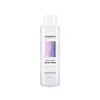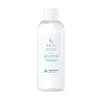What's inside
What's inside
 Key Ingredients
Key Ingredients

 Benefits
Benefits

 Ingredients Side-by-side
Ingredients Side-by-side

Arctium Lappa Root Extract
Skin ConditioningWater
Skin ConditioningGlycerin
HumectantGlycereth-26
HumectantNiacinamide
Smoothing1,2-Hexanediol
Skin ConditioningBetaine
HumectantSilybum Marianum Seed Extract
Skin ConditioningCentella Asiatica Extract
CleansingMadecassoside
AntioxidantSodium Hyaluronate
HumectantAdenosine
Skin ConditioningButylene Glycol
HumectantDisodium EDTA
Hydroxyacetophenone
AntioxidantEthylhexylglycerin
Skin ConditioningCitric Acid
BufferingSodium Citrate
BufferingArctium Lappa Root Extract, Water, Glycerin, Glycereth-26, Niacinamide, 1,2-Hexanediol, Betaine, Silybum Marianum Seed Extract, Centella Asiatica Extract, Madecassoside, Sodium Hyaluronate, Adenosine, Butylene Glycol, Disodium EDTA, Hydroxyacetophenone, Ethylhexylglycerin, Citric Acid, Sodium Citrate
Bambusa Vulgaris Water 85%
Skin ConditioningGlycereth-26
HumectantGlycerin
HumectantWater
Skin Conditioning1,2-Hexanediol
Skin ConditioningHydroxyethyl Urea
HumectantButylene Glycol
HumectantSodium Hyaluronate
HumectantPolyglutamic Acid
Skin ConditioningLonicera Japonica Flower Extract
Skin ConditioningScutellaria Baicalensis Root Extract
AstringentForsythia Suspensa Fruit Extract
AntioxidantChamaecyparis Obtusa Leaf Extract
Skin ConditioningThuja Orientalis Extract
AntimicrobialPinus Densiflora Extract
AntioxidantBambusa Vulgaris Extract
Skin ConditioningSodium Citrate
BufferingCitric Acid
BufferingDisodium EDTA
Bambusa Vulgaris Water 85%, Glycereth-26, Glycerin, Water, 1,2-Hexanediol, Hydroxyethyl Urea, Butylene Glycol, Sodium Hyaluronate, Polyglutamic Acid, Lonicera Japonica Flower Extract, Scutellaria Baicalensis Root Extract, Forsythia Suspensa Fruit Extract, Chamaecyparis Obtusa Leaf Extract, Thuja Orientalis Extract, Pinus Densiflora Extract, Bambusa Vulgaris Extract, Sodium Citrate, Citric Acid, Disodium EDTA
Ingredients Explained
These ingredients are found in both products.
Ingredients higher up in an ingredient list are typically present in a larger amount.
1,2-Hexanediol is a synthetic liquid and another multi-functional powerhouse.
It is a:
- Humectant, drawing moisture into the skin
- Emollient, helping to soften skin
- Solvent, dispersing and stabilizing formulas
- Preservative booster, enhancing the antimicrobial activity of other preservatives
Butylene Glycol (or BG) is used within cosmetic products for a few different reasons:
Overall, Butylene Glycol is a safe and well-rounded ingredient that works well with other ingredients.
Though this ingredient works well with most skin types, some people with sensitive skin may experience a reaction such as allergic rashes, closed comedones, or itchiness.
Learn more about Butylene GlycolCitric Acid is an alpha hydroxy acid (AHA) naturally found in citrus fruits like oranges, lemons, and limes.
Like other AHAs, citric acid can exfoliate skin by breaking down the bonds that hold dead skin cells together. This helps reveal smoother and brighter skin underneath.
However, this exfoliating effect only happens at high concentrations (20%) which can be hard to find in cosmetic products.
Due to this, citric acid is usually included in small amounts as a pH adjuster. This helps keep products slightly more acidic and compatible with skin's natural pH.
In skincare formulas, citric acid can:
While it can provide some skin benefits, research shows lactic acid and glycolic acid are generally more effective and less irritating exfoliants.
Most citric acid used in skincare today is made by fermenting sugars (usually from molasses). This synthetic version is identical to the natural citrus form but easier to stabilize and use in formulations.
Read more about some other popular AHA's here:
Learn more about Citric AcidDisodium EDTA plays a role in making products more stable by aiding other preservatives.
It is a chelating agent, meaning it neutralizes metal ions that may be found in a product.
Disodium EDTA is a salt of edetic acid and is found to be safe in cosmetic ingredients.
Learn more about Disodium EDTAGlycereth-26 is a synthetic ingredient and polyethylene glycol ether of Glycerin. Glycerin is already naturally found in your skin and helps keep your skin moisturized.
It is a humectant and helps add texture to products. It can make your product thicker.
As a humectant, it helps draw moisture from the air to your skin. This helps your skin stay hydrated.
Learn more about Glycereth-26Glycerin is already naturally found in your skin. It helps moisturize and protect your skin.
A study from 2016 found glycerin to be more effective as a humectant than AHAs and hyaluronic acid.
As a humectant, it helps the skin stay hydrated by pulling moisture to your skin. The low molecular weight of glycerin allows it to pull moisture into the deeper layers of your skin.
Hydrated skin improves your skin barrier; Your skin barrier helps protect against irritants and bacteria.
Glycerin has also been found to have antimicrobial and antiviral properties. Due to these properties, glycerin is often used in wound and burn treatments.
In cosmetics, glycerin is usually derived from plants such as soybean or palm. However, it can also be sourced from animals, such as tallow or animal fat.
This ingredient is organic, colorless, odorless, and non-toxic.
Glycerin is the name for this ingredient in American English. British English uses Glycerol/Glycerine.
Learn more about GlycerinSodium Citrate is the sodium salts of citric acid. In skincare, it is used to alter pH levels and acts as a preservative.
Its main functions are to maintain the pH of a product and neutralize metal ions.
The acidity of our skin is maintained by our glands and skin biome; normal pH level of skin is slightly acidic (~4.75-5.5).
Being slightly acidic allows our skin to create an "acid mantle". This acid mantle is a thin barrier that protects our skin from bacteria and contaminants.
Learn more about Sodium CitrateSodium Hyaluronate is hyaluronic acid's salt form. It is commonly derived from the sodium salt of hyaluronic acid.
Like hyaluronic acid, it is great at holding water and acts as a humectant. This makes it a great skin hydrating ingredient.
Sodium Hyaluronate is naturally occurring in our bodies and is mostly found in eye fluid and joints.
These are some other common types of Hyaluronic Acid:
Learn more about Sodium HyaluronateWater. It's the most common cosmetic ingredient of all. You'll usually see it at the top of ingredient lists, meaning that it makes up the largest part of the product.
So why is it so popular? Water most often acts as a solvent - this means that it helps dissolve other ingredients into the formulation.
You'll also recognize water as that liquid we all need to stay alive. If you see this, drink a glass of water. Stay hydrated!
Learn more about Water